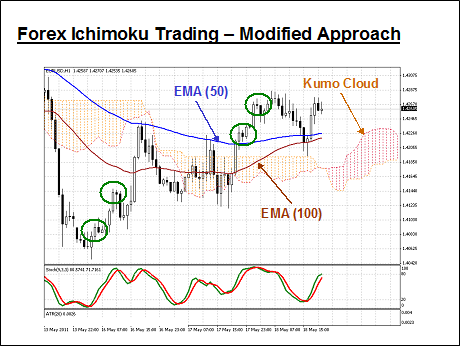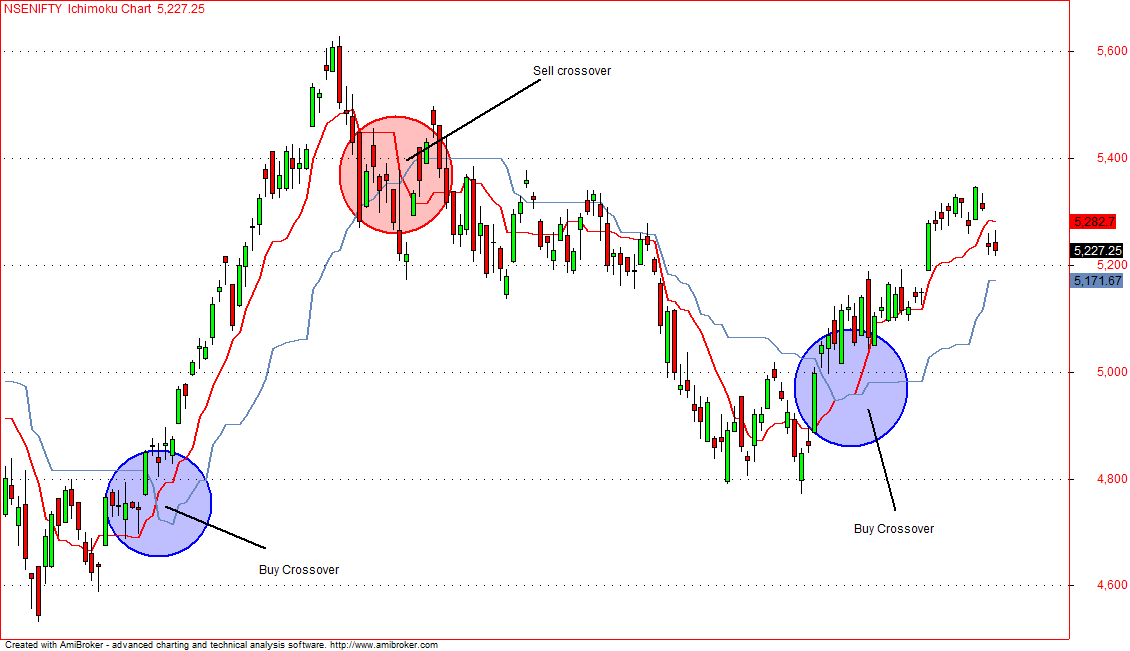Ichimoku Trading System ~ Forex Market Stocks
Post on: 1 Апрель, 2015 No Comment

Everything about trading fx spot, futures. Free MT4 indicators, expert advisers (EA).
Quick Description
Ichimoku Kinko Hyo is a purpose-built trend trading charting system that has been successfully used in nearly every tradeable market. It is unique in many ways, but its primary strength is its use of multiple data points to give the trader a deeper, more comprehensive view into price action. This deeper view, and the fact that Ichimoku is a very visual system, enables the trader to quickly discern and filter at a glance the low-probability trading setups from those of higher probability.
History
The charting system of Ichimoku Kinko Hyo was developed by a Japanese newspaper man named Goichi Hosoda. He began developing this system before World War II with the help of numerous students that he hired to run through the optimum formulas and scenarios — analogous to how we would use computer simulated backtesting today to test a trading system. The system itself was finally released to the public in 1968, after more than twenty years of testing, when Mr. Hosoda published his book which included the final version of the system.
Ichimoku Settings
As you can see in the Ichimoku Components section above, each line calculation has one and sometimes two different settings based on the number of periods considered. After much research and backtesting, Goichi Hosoda finally determined that the settings of 9, 26 and 52 were the ideal settings for obtaining optimum results with Ichimoku. He derived the number 26 from what was then the standard Japanese business month (which included Saturdays). The number 9 represents a week and a half and the number 52 represents two months.
There is some debate around whether or not these settings of 9,26,52 are still valid given that the standard work month here in the West does not include Saturdays. In addition, in non-centralized markets that do not keep standard business hours like the Forex (which trades around the clock) some have posited that there may be more appropriate settings. Nevertheless, we at Boersma & Hunt, as well as most other professional Ichimoku traders, agree that the standard settings of 9,26,52 work extremely well and do not need to be altered.
Thus, for the purposes of describing Ichimoku Kinko Hyo within this wiki, it will be assumed that the standard settings are being used.
Ichimoku components
Tenkan Sen
The tenkan sen, as we have already mentioned in our Introduction section, is calculated in the following manner:
While many may compare the tenkan sen to a simple 9 period simple moving average (SMA), it is quite different in the sense that it measures the average of price’s highest high and lowest low for the last 9 periods. Hosoda believed that using the average of price extremes over a given period of time was a better measure of equilibrium than merely using an average of the closing price. This study of the tenkan sen will provide us with our first foray into the key aspect of equilibrium that is so prevalent in the Ichimoku Kinko Hyo charting system.
Consider the chart in Figure I below:
FIGURE I — Tenkan Sen vs. 9 Period SMA
As can be seen in the chart, the tenkan sen often exhibits flattening whereas the 9 period SMA does not. This is due to the fact that the tenkan sen uses the average of the highest high and lowest low rather than an average of the closing price. Thus, during periods of price ranging, the tenkan sen will clearly show the midpoint of the range via its flat aspect.
It can also be seen how the tenkan sen provides a much more accurate level of price support than does the 9 period SMA. With only one exception, price action stayed above the tenkan sen in the three highlighted areas of the chart, while price broke below the SMA numerous times. This is due to the more conservative manner in which the tenkan sen is calculated, which makes it less reactive to small movements in price. On a bearish chart, the tenkan sen will likewise act as a level of resistance.

The angle of the tenkan sen can also give us an idea of the relative momentum of price movements over the last 9 periods. A steeply angled tenkan sen will indicate a nearly vertical price rise over a short period of time or strong momentum, whereas a flatter tenkan sen will indicate lower momentum or no momentum over that same time period.
The tenkan sen and the kijun sen both measure the shorter-term trend. Of the two, the tenkan sen is the fastest given that it measures trend over the past 9 periods as opposed to the kijun sen’s 26 periods. Thus, given the very short term nature of the tenkan sen, it is not as reliable an indicator of trend as many other components of Ichimoku. Nevertheless, price breaching the tenkan sen can give an early indication of a trend change. though, like all Ichimoku signals, this should be confirmed by the other Ichimoku components before making any trading decision.
One of the primary uses of the tenkan sen is vis-a-vis its relation to the kijun sen. If the tenkan sen is above the kijun sen, then that is a bullish signal. Likewise, if the tenkan sen is below the kijun sen, then that is bearish. The crossover of these two lines is actually a trading signal on its own, at topic that is covered in more detail in Ichimoku Trading Strategies section.
Kijun Sen
The kijun sen is calculated in the following manner:
The kijun sen is one of the true workhorses of Ichimoku Kinko Hyo and it has myriad applications. Like its brother, the tenkan sen, the kijun sen measures the average of price’s highest high and lowest low. though it does so over a longer time frame of 26 periods as opposed to the tenkan sen’s 9 periods. The tenkan sen thus provides us with all the information the tenkan sen does, just on a longer time frame.
Due to the longer time period it measures, the kijun sen is a more reliable indicator of short-term price sentiment, strength and equilibrium than the tenkan sen. If price has been ranging, then the kijun sen will reflect the vertical midpoint of that range (price equilibrium) via its flat aspect. Once price exceeds either the last highest high or lowest low within the last 26 periods, however, the kijun sen will reflect that by either angling up or down, respectively. Thus, short-term trend can be measured by the direction of the kijun sen. In addition, the relative angle of the kijun sen will indicate the strength or momentum of the trend.
Price equilibrium is expressed even more accurately in the kijun sen than in the tenkan sen, given the longer period of time it considers. Thus, the kijun sen can be relied upon as a significant level of price support and resistance (see highlighted areas in Figure II below).
Price tends to move alternately away from and back toward the kijun sen in a cyclical fashion due to the kijun sen’s strong expression of equilibrium or stasis. Thus, when price momentum is extreme and price moves rapidly up or down over a short period of time, a certain rubber band effect can be observed on price by the kijun sen, attracting price back towards itself and bringing it back to equilibrium. An analogy could be made between how price interacts with the kijun sen and how electricity always seeks to return to ground or zero potential. The ground in this case is the kijun sen and price will always seek to return to that level. This phenomenon is particularly evident when the kijun sen is flat or trendless, as can be seen in Figure III below:














